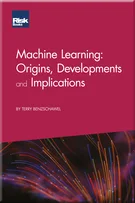Supervised learning
Miquel Noguer i Alonso, Daniel Bloch and David Pacheco Aznar
Supervised learning
In the previous chapters, we have presented artificial and recurrent neural networks, discussing the construction of neurons and introducing different networks with their respective algorithms. We shall now give a more formal representation of such networks.
5.1 INTRODUCTION TO LEARNING THEORY
Vapnik (1982) developed a fundamental approach to learning theory called structural risk minimisation. In this section we introduce the main ideas.
5.1.1 Function estimation
Risk minimisation
In a general supervised learning problem, we have two spaces of objects X and Y and would like to learn a function h: X → Y, which outputs an object y ∈ Y, given x ∈ X. The function h is sometimes called a score function or hypothesis. It is an element of some space of possible functions H called the hypothesis space. We assume a given sample {(x1, y1), . . . , (xn, yn)}, where xi ∈ X is an input and yi ∈ Y is the corresponding response that we wish to get from h(xi). We consider probabilistic learning models and assume that there is a joint probability distribution P(x, y) and that the sample is made of independent and identically distributed (iid) variables drawn from that distribution. That is, we model
Copyright Infopro Digital Limited. All rights reserved.
As outlined in our terms and conditions, https://www.infopro-digital.com/terms-and-conditions/subscriptions/ (point 2.4), printing is limited to a single copy.
If you would like to purchase additional rights please email info@risk.net
Copyright Infopro Digital Limited. All rights reserved.
You may share this content using our article tools. As outlined in our terms and conditions, https://www.infopro-digital.com/terms-and-conditions/subscriptions/ (clause 2.4), an Authorised User may only make one copy of the materials for their own personal use. You must also comply with the restrictions in clause 2.5.
If you would like to purchase additional rights please email info@risk.net











